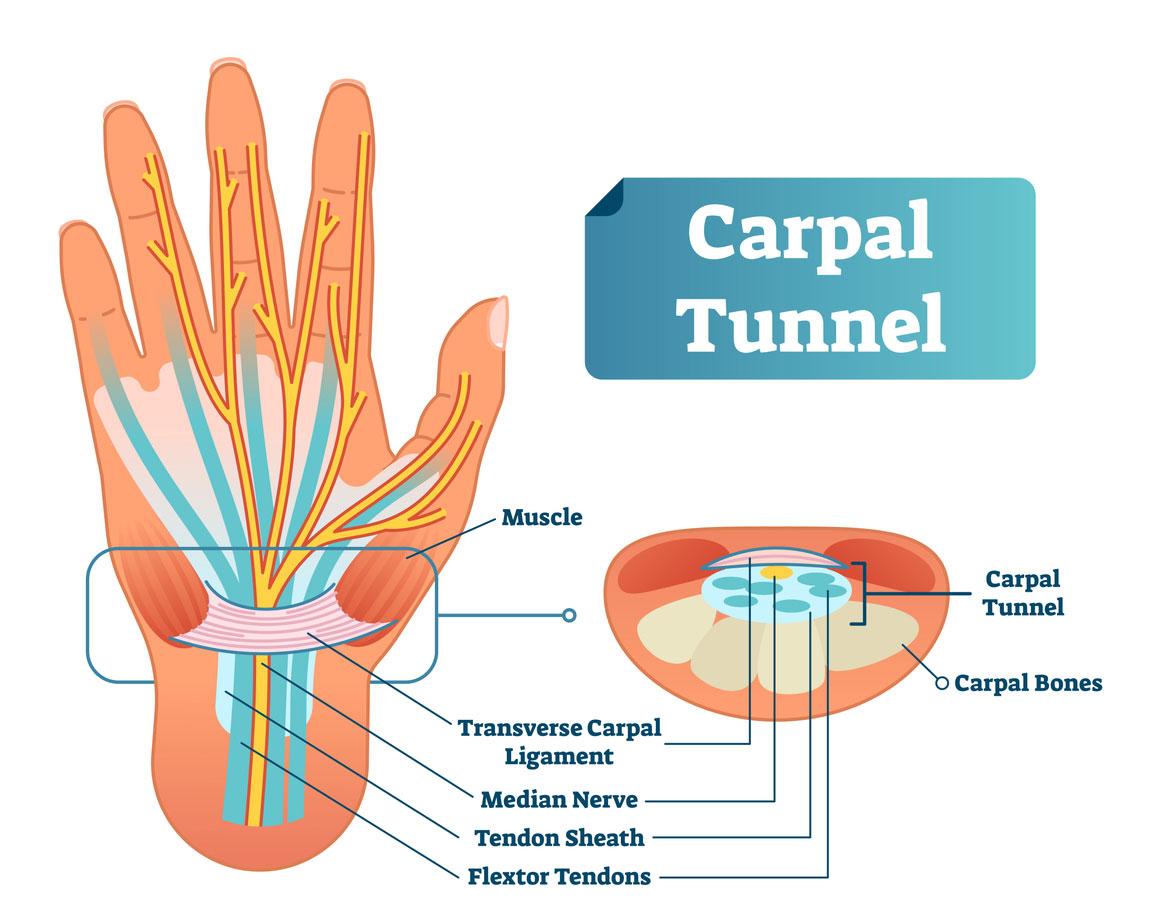Carpal Tunnel Syndrome
Description
What is Carpal Tunnel Syndrome?
Carpal tunnel syndrome, aka CTS, is a common medical condition affecting the hand and wrist by causing discomfort, pain, and numbness. It occurs when the median nerve, which runs through a narrow passageway in the wrist called the carpal tunnel, becomes compressed or irritated. This compression can result from various factors, such as repetitive hand and wrist movements, prolonged or improper hand positioning, or underlying health conditions.
The carpal tunnel is a narrow passage formed by bones and a thick ligament in the wrist. Within this tunnel, the median nerve, along with tendons that control finger movement, travels from the forearm to the hand. When the space within the carpal tunnel diminishes or the tissues surrounding it become inflamed, the median nerve becomes compressed.
One of the primary symptoms of carpal tunnel syndrome is a tingling or numbness sensation in the thumb, index finger, middle finger, and half of the ring finger. This numbness is often accompanied by pain, which can radiate from the wrist to the forearm or even up to the shoulder. Individuals with CTS may also experience weakness in the affected hand, making it challenging to grip objects or perform delicate tasks.
The symptoms of carpal tunnel syndrome typically worsen during activities that involve repetitive hand and wrist movements, such as typing, using a computer mouse, or engaging in certain sports. Symptoms may also be more prominent at night, causing disrupted sleep patterns. Over time, if left untreated, CTS can lead to muscle wasting in the hand and a decrease in hand function.
Treatment for carpal tunnel syndrome aims to relieve the compression on the median nerve and alleviate symptoms. Non-surgical approaches often include wrist splinting, activity modification, and the application of cold packs or nonsteroidal anti-inflammatory drugs (NSAIDs) to reduce inflammation. Physical therapy exercises can help improve hand and wrist strength and flexibility. In more severe cases or when conservative treatments fail, surgical intervention may be recommended to relieve pressure on the median nerve and restore normal hand function.
It is important to consult with a healthcare professional for an accurate diagnosis and appropriate management of carpal tunnel syndrome. Early detection and treatment can help alleviate symptoms, prevent further nerve damage, and improve the overall quality of life for individuals affected by this condition.
The carpal tunnel is a narrow passage formed by bones and a thick ligament in the wrist. Within this tunnel, the median nerve, along with tendons that control finger movement, travels from the forearm to the hand. When the space within the carpal tunnel diminishes or the tissues surrounding it become inflamed, the median nerve becomes compressed.
One of the primary symptoms of carpal tunnel syndrome is a tingling or numbness sensation in the thumb, index finger, middle finger, and half of the ring finger. This numbness is often accompanied by pain, which can radiate from the wrist to the forearm or even up to the shoulder. Individuals with CTS may also experience weakness in the affected hand, making it challenging to grip objects or perform delicate tasks.
The symptoms of carpal tunnel syndrome typically worsen during activities that involve repetitive hand and wrist movements, such as typing, using a computer mouse, or engaging in certain sports. Symptoms may also be more prominent at night, causing disrupted sleep patterns. Over time, if left untreated, CTS can lead to muscle wasting in the hand and a decrease in hand function.
Treatment for carpal tunnel syndrome aims to relieve the compression on the median nerve and alleviate symptoms. Non-surgical approaches often include wrist splinting, activity modification, and the application of cold packs or nonsteroidal anti-inflammatory drugs (NSAIDs) to reduce inflammation. Physical therapy exercises can help improve hand and wrist strength and flexibility. In more severe cases or when conservative treatments fail, surgical intervention may be recommended to relieve pressure on the median nerve and restore normal hand function.
It is important to consult with a healthcare professional for an accurate diagnosis and appropriate management of carpal tunnel syndrome. Early detection and treatment can help alleviate symptoms, prevent further nerve damage, and improve the overall quality of life for individuals affected by this condition.

As shown above, the Carpal Tunnel is formed between the transverse carpal ligament and the carpal bones of the wrist. When compression and reduced blood flow to the median nerve occur as it passes through the carpal tunnel in the wrist, Carpal Tunnel Syndrome occurs. The compression results from swelling of one or more of the nine tendons that pass through the tunnel and manifests itself as pain, numbness, or a tingling sensation in the first 4 digits of the hand. Since these tendons are responsible for the flexing motion of the fingers, excessive and repetitive movements of the fingers such as when typing is often one of the root causes of Carpal Tunnel Syndrome.
Other factors that may cause Carpal Tunnel Syndrome include:
Hormonal or metabolic changes
Fractures/strains/sprains around the wrist
Diabetes
Exposure to repetitive vibration
Family history
How Can Massage Therapy Help Relieve Carpal Tunnel Syndrome?
Massage therapy is known to be one of the least invasive, cost-effective, and longest-lasting treatments to address Carpal Tunnel Syndrome. Why? Because massage therapy helps reduce inflammation, pain, and numbness/tingling by softening up the muscles and fascia and also lengthening them.
Typically deep tissue massage is required to help release the adhesions, trigger points, and tension in the soft tissues affected including the shoulder, arm, and hand.
While massage therapy alone may not cure CTS, it can help alleviate symptoms and promote overall hand and wrist health. Here are some ways in which massage therapy can assist in the treatment of carpal tunnel syndrome:
1. Improved blood circulation: Massage techniques can enhance blood flow to the affected area, promoting the delivery of oxygen and essential nutrients to the tissues. Increased circulation can help reduce inflammation and swelling, which are common contributors to CTS symptoms.
2. Reduction of muscle tension: Massage therapy can target tight muscles and knots in the hand, wrist, forearm, and even the upper arm or shoulder. By releasing tension and relieving muscle knots, massage can help reduce strain on the wrist and alleviate pain associated with CTS.
3. Enhanced joint mobility and flexibility: Massage techniques, such as stretching, passive joint mobilization, and myofascial release, can help improve joint mobility and increase flexibility in the wrist and hand. This can be particularly beneficial for individuals with CTS who experience stiffness and limited range of motion.
4. Nerve compression relief: Massage therapy can aid in releasing pressure on the median nerve, which is compressed in carpal tunnel syndrome. Techniques like gentle stretching, manual traction, and specific pressure point work can help decompress the nerve, alleviating symptoms such as tingling, numbness, and pain.
5. Relaxation and stress reduction: CTS symptoms can be exacerbated by stress and tension. Massage therapy induces a state of relaxation, reduces stress levels, and promotes an overall sense of well-being. By addressing the emotional and physical aspects of stress, massage therapy can indirectly help manage CTS symptoms.
Our massage therapists are skilled and experienced in the treatment of CTS. They possess in-depth knowledge of carpal tunnel syndrome and understand the appropriate techniques and precautions for treatment. Massage therapy plays a vital role as part of a comprehensive treatment plan, incorporating other interventions such as ergonomic modifications, exercises, and medical advice.
At Urban Massage, our Registered Massage Therapists will share with you some stretches that you can perform in between treatments that will serve to speed up the recovery process. Although you will likely experience relief after the first session, it may take between 4 to 6 sessions to achieve long-term relief depending on the severity and length of time you have experienced the symptoms. This is why we recommend seeking out treatment at the first signs of any symptoms of Carpal Tunnel Syndrome as early treatment is one of the best forms of prevention.
As always, if symptoms persist it is always recommended to speak to your Doctor as there may be other underlying health issues that need to be addressed.
Details
| Date Added | 2022-12-17 |
| Product Id | 10543822 |






